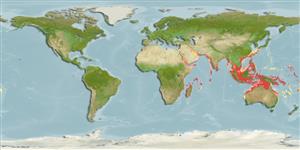Environment: milieu / climate zone / depth range / distribution range
Ecology
Marine; demersal. Tropical
Indo-West Pacific: Mauritius and India to Papua New Guinea; north to China; south to Australia,
Size / Weight / Age
Maturity: Lm ? range ? - ? cm
Max length : 13.9 cm SL male/unsexed; (Ref. 75583)
Short description
Identification keys | Morphology | Morphometrics
Dorsal spines (total): 8; Dorsal soft rays (total): 16; Anal spines: 3; Anal soft rays: 14 - 15. This species belonging to the Leiognathus splendens complex is distinguished by the following characters: cheek no scales; anterior dorsolateral body surface almost entirely scaled with a semicircular naked area on nape; lower margin of inner preopercular ridge smooth; no scales on interspace of pelvic keels; second spines of dorsal and anal fins are weak (width of second spines of dorsal and anal fins 0.72-1.1% SL and 0.60-0.95% SL, respectively); a dark blotch on spinous dorsal fin rather pale, grayish (Ref. 75583).
Life cycle and mating behavior
Maturities | Reproduction | Spawnings | Egg(s) | Fecundities | Larvae
Kimura, S., T. Ito, T. Peristiwady, Y. Iwatsuki, T. Yoshino and P.N. Dunlap, 2005. The Leiognathus splendens complex (Perciformes: Leignothidae) with the description of a new species, Leiognathus kupanensis kimura and Peristiwady. Ichthyol. Res. 52 (3):275-291. (Ref. 75583)
IUCN Red List Status (Ref. 130435)
Threat to humans
Harmless
Human uses
Tools
Special reports
Download XML
Internet sources
Estimates based on models
Preferred temperature (Ref.
123201): 24.7 - 29.1, mean 28 °C (based on 1632 cells).
Phylogenetic diversity index (Ref.
82804): PD
50 = 0.5625 [Uniqueness, from 0.5 = low to 2.0 = high].
Bayesian length-weight: a=0.01862 (0.00823 - 0.04215), b=2.97 (2.78 - 3.16), in cm total length, based on LWR estimates for this (Sub)family-body shape (Ref.
93245).
Trophic level (Ref.
69278): 3.0 ±0.4 se; based on size and trophs of closest relatives
Resilience (Ref.
120179): High, minimum population doubling time less than 15 months (Preliminary K or Fecundity.).
Fishing Vulnerability (Ref.
59153): Low vulnerability (10 of 100).
